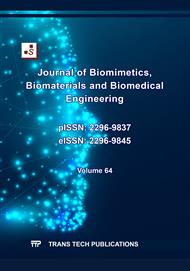[1]
Y. Zhang, M. Li, X. Gao, Y. Chen, and T. Liu, Nanotechnology in cancer diagnosis: Progress, challenges and opportunities. J. Hematol. Oncol., 12 (2019) 1–13.
DOI: 10.1186/s13045-019-0833-3
Google Scholar
[2]
J. G. Elmore, M. B. Barton, V. M. Moceri, S. Polk, P. J. Arena, and S. W. Fletcher, Ten-year risk of false positive screening mammograms and clinical breast examinations, New England J. Med., 338 (1998) 1089–1096.
DOI: 10.1056/nejm199804163381601
Google Scholar
[3]
P. Skaane, S. Hofvind, and A. Skjennald, Randomized trial of screen-film versus full-field digital mammography with soft-copy reading in population-based screening program: Follow-up and final results of Oslo II study, Radiology, 244 (2007) 708–717.
DOI: 10.1148/radiol.2443061478
Google Scholar
[4]
P. A. Carney et al., Individual and combined effects of age, breast density, and hormone replacement therapy use on the accuracy of screen- ing mammography, Ann. Internal Med., 138 (2003) 168–175.
DOI: 10.7326/0003-4819-138-3-200302040-00008
Google Scholar
[5]
S. J. Lord et al., A systematic review of the effectiveness of magnetic resonance imaging (MRI) as an addition to mammography and ultra- sound in screening young women at high risk of breast cancer, Eur. J. Cancer, 43 (2007) 1905–1917.
DOI: 10.1016/j.ejca.2007.06.007
Google Scholar
[6]
M. Al-Foheidi, M. M. Al-Mansour, and E. M. Ibrahim, Breast cancer screening: Review of benefits and harms, and recommendations for developing and low-income countries, Med. Oncol., 30 (2013) 471.
DOI: 10.1007/s12032-013-0471-5
Google Scholar
[7]
E. C. Fear, P. M. Meaney, and M. A. Stuchly, Microwaves for breast cancer detection. IEEE Potentials, 22 (2003) 12–18.
DOI: 10.1109/mp.2003.1180933
Google Scholar
[8]
M. Säbel and H. Aichinger, Recent developments in breast imaging, Phys. Med. Biol., 41(1996) 315–368.
DOI: 10.1088/0031-9155/41/3/001
Google Scholar
[9]
G. Bindu, S. Abraham, C. K. Aanandan, and K. T. Mathew, Microwave characterization of female human breast tissues, in Proc. 9th Eur. Conf. Wireless Technol., (2006) 123–126.
DOI: 10.1109/ecwt.2006.280450
Google Scholar
[10]
U. M. Pal et al., Optical spectroscopy-based imaging techniques for the diagnosis of breast cancer: A novel approach, Appl. Spectrosc. Rev., 55 (2020) 778–804.
Google Scholar
[11]
Vimala, P., Krishna, L.L. & Sharma, S.S. TFET Biosensor Simulation and Analysis for Various Biomolecules. Silicon 14 (2022) 7933–7938.
DOI: 10.1007/s12633-021-01570-x
Google Scholar
[12]
E. C. Fear, X. Li, S. C. Hagness, and M. A. Stuchly, Confocal microwave imaging for breast cancer detection: Localization of tumors in three dimensions, IEEE Trans. Biomed. Eng., 49 (2002) 812–822.
DOI: 10.1109/tbme.2002.800759
Google Scholar
[13]
S. Chaudhary, R. Mishra, A. Swarup, and J. Thomas, Dielectric properties of normal and malignant human breast tissues at radio wave and microwave frequencies, Indian J. Biochem. Biophys., 21 (1981) 76–79.
Google Scholar
[14]
J. E. Jeyanthi, T. S. Arun Samuel, A. Sharon Geege & Vimala P, A Detailed Roadmap from Single Gate to Heterojunction TFET for Next Generation Devices, Silicon, 14 (2022) 3185–3197.
DOI: 10.1007/s12633-021-01148-7
Google Scholar
[15]
R. Vishnoi and M. J. Kumar, Compact analytical drain current model of gate-all-around nanowire tunneling FET, IEEE Trans. Electron Devices, 61(2014) 2599–2603.
DOI: 10.1109/ted.2014.2322762
Google Scholar
[16]
G.H Nayana, P.Vimala, M Karthigai Pandian and T.S. Arun Samuel, Simulation insights of a new Dual Gate Graphene Nano-Ribbon Tunnel Field-Effect Transistors for THz applications, Diamond & Related Materials, 121, (2022) 1-7.
DOI: 10.1016/j.diamond.2021.108784
Google Scholar
[17]
S. Singh and S. Singh, Dopingless Negative Capacitance Ferroelectric TFET for Breast Cancer Cells Detection: Design and Sensitivity Analysis, in IEEE Transactions on Ultrasonics, Ferroelectrics, and Frequency Control, 69 (2022) 1120-1129.
DOI: 10.1109/tuffc.2021.3136099
Google Scholar
[18]
S. Singh and S. Singh, Analog/RF performance projection of ultra-steep Si doped HfO2 based negative capacitance electrostatically doped TFET: A process variation resistant design, Silicon 14 (2022) 4865–4877.
DOI: 10.1007/s12633-021-01259-1
Google Scholar
[19]
M.K Bind, S.V Singh, K.Kumar Nigam, Design and Investigation of the DM- PC-TFET-Based Biosensor for Breast Cancer Cell Detection, Trans. Electr. Electron. Mater., 24 (2023) 381–395.
DOI: 10.1007/s42341-023-00453-9
Google Scholar
[20]
R.Abdulnassir A.Singh, D.Tekilu, Assessment of Hetero-Structure Junction-Less Tunnel FET's Efficacy for Biosensing Applications, Sens Imaging, 25 (2024) 6.
DOI: 10.1007/s11220-023-00455-0
Google Scholar
[21]
Tran Thanh Hoai, Phan Thi Yen, Tran Thi Bich Dao, Luu Hai Long, Duong Xuan Anh, Luu Hai Minh, Bui Quoc Anh, Nghiem Thi Thuong, Evaluation of the cytotoxic effect of rutin prenanoemulsion in lung and colon cancer cell lines, J. Nanomater., 8867669 (2020) 1–11.
DOI: 10.1155/2020/8867669
Google Scholar


